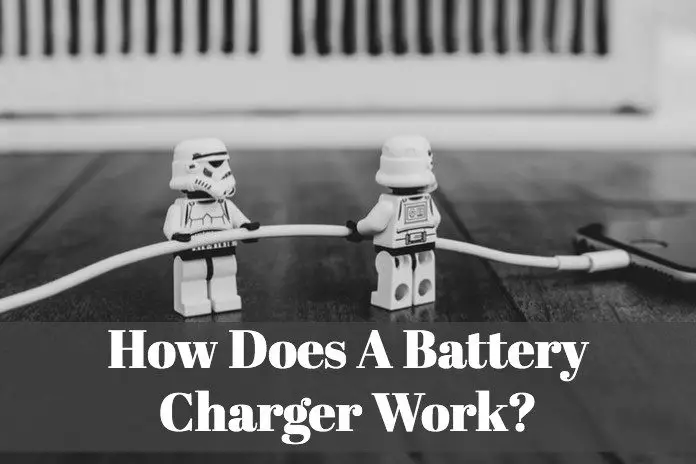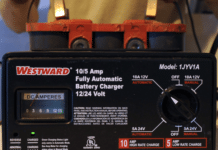
Battery chargers become an essential tool when we buy batteries of any kind. A lot of rechargeable batteries are coming out, and it is becoming a part of our system. It became a big part of our lives, and so do battery chargers.
Rechargeable batteries save us a lot of money. Therefore, to complete out savings, we need to invest with a good charger to make our savings significant enough to purchase other needs.
How Does a Battery Charger Work? A battery charger is the kind of device that we used to supply energy and power to a battery or rechargeable batteries. It works by pushing the electric current through the cell. It recharges a depleted battery; in other words, a recharger returns the array into life.
It is indeed very essential to know why battery chargers should be given the same importance as the battery. After all, without the charger, we cannot do anything to our dead battery. There are many different types of chargers, depending on battery types and sizes.
You better read and find the most appropriate battery chargers for your battery below!
What Is A Battery?
Batteries powers our electronic gadgets and other appliances. Defining battery will lead us to more understanding of what it is and how it works. Batteries are cells that have chemical reactions that create a flow of the electrons within the circuit.
A battery has three essential components; the anode, the cathode, and an electrolyte. When the battery’s anode and the cathode connected to a circuit, the chemical reaction happens between the electrolyte and anode.
This kind of response is what makes the electrons flow to the course and returns to the cathode if there is another chemical reaction. When this process of the cycle between the anode and cathode failed to take place, the battery is unable to make electricity. This stage is what we call as the dead battery stage.
Secondary batteries are those that can be recharged while batteries that should be disposed of after getting used is a primary battery.
How Do Batteries Work?
When electrons flow through a path, we call it as electricity. The way through which the power flows is called a circuit. Batteries, as I have mentioned above, is composed of three parts: the anode, cathode and the electrolyte which are all connected to an electrical circuit.
The battery produces chemical reactions which create the building up of electrons in the anode. It then creates different electrical responses in the anode and cathode. This difference is what we call as the unstable electron build-up.
Particles then, rearrange themselves to remove this difference. Electrons do this by repelling each other and going to a place where there are fewer electrons.
For batteries, this place with fewer electrons is the cathode. However, the electrolyte continues to push the particles in going to the anode and the cathode in the battery. If you have a closed circuit, electrons will get to the cathode quickly.
These process in the electrochemical makes the chemicals in the anode and cathode change, to stop the supply of electrons. This process limits the amount of power in the battery.
In recharging the battery, you are changing the direction of the electron’s flow through the use of another source of energy such as the solar battery’s or panels.
The process of the electrochemical goes in the reverse where the anode and the cathode restore to its original state and can work in providing a total power.
How Does A Battery Charger Work?
Battery chargers are devices that we used to give power to our batteries again. Instead of throwing batteries for disposal, a rechargeable one can be used over and over again. Battery chargers save us from spending a lot of money buying batteries again and again.
But, how do battery chargers really work?
I can say that all chargers have the same thing in common: They provide electric current to the batteries for a specific time thinking that cells inside the battery will be able to hold to the energy which is passed through the charger. That is what I mentioned above their similar functions.
The simplest and cheapest chargers either use a constant voltage or a current that is constant which applies them to a battery until it is switched off. If you forget to switch them off, you will be overcharging your batteries. If you turned it off soon, you wouldn’t be able to charge it well.
The unique charger types use a lower and gentler charge, we call it the trickle chargers. These chargers can be left out without overcharging your batteries.
Charging a battery reverses the chemical reactions which happen during its discharge state. Like suitcases, you will find it hard to pack in if you have already packed in more, batteries work like that.
An example is a lithium-ion battery of a laptop. The charge and discharge involve the shunting of the lithium-ion.
Batteries are harder to charge in the last stage. The last 25% is the longest to fill in with charge compared to the first 75%. Overcharging the battery is worst than undercharging it. If the batteries are all fully charged and you failed to switch it off.
The battery needs to get rid of the extra power that you are putting it through charging. It will eventually create a build-up inside the cell. They do this by overheating and building up pressure inside the battery.
Finally, overheating will bring in the leaks rupture which can eventually explode.
Ways To Measure The Charging Or Discharging Time Of Your Battery
Knowing how to charge your batteries save you from the damage that may happen to it when you overcharge or undercharge it. There is a smart way to calculate the battery’s charging time all by yourself. Find out how.
1. You need to divide the load or power by 1000 to get the value in kilowatts.
Ex. 3.681 W = 3.7 kilowatts
2. You need to divide your battery’s power (in kW also) by the number obtained to get the charging time.
Ex. 24kW/3.8kW = 6.3 hours
3. Calculate your load energy or power (P) by getting the factor of the voltage (U in volts) and the current (I, amperes) then you will get its value in watts. So you will have a formula of P=U x I
Ex. 15 A x 225 V = 3,375 W
Type Of Battery Charger You Need To Know (Car, AAA, and Rechargeable Batteries)
There are different battery chargers needed for a different type of batteries. There are car batteries, AAA and rechargeable batteries. Each one of these batteries requires a specific particular type of charger to make sure that it charges the batteries properly.
Car Battery Charger
Short, frequent trips with a lot of stopping and starting will make it hard for your battery to sustain its power. It also tends to fail quickly if you engage in these short trips most often.
There is a possibility of having a flat battery all the time when the current is always drained from the battery. A charger will help you recharge the power back to your cells.
Car battery charger uses the current to replenish the lost charge in your battery. They use it through the positive and the contrary ends of the battery that connects to the battery posts.
AAA Charger
An AAA charger is the charger used for AAA and AA Ni-MH batteries that we often used for flashlights, clocks, radio, and other household appliance.
This charger charges in pairs which can accommodate at least two or four AA or AAA batteries at the same time. As soon as you correctly charge and plug it, it will begin charging automatically.
When the batteries are already fully charged, you have to remove the cells from the charger to prevent it from overcharging.
Rechargeable Battery Charger
You will need a reliable battery charger for your rechargeable batteries. There is plenty of combo charger where you can charge multiple types of cells and several batteries at the same time.
AA and AAA batteries that are rechargeable will work best with this type of chargers. Often, these chargers can be plugged directly to any wall outlet. Chargers like this are compact and portable. You can bring it anywhere.
You Should Match the Batteries To The Charger
Your batteries should equally match the charger that you are going to use. Otherwise, if your batteries and charger don’t match it will create a bigger problem. You should consider the following in matching the batteries and chargers.
● Battery Chemistry
● Voltage of charging
● Charging Current
● Level of Quality for Chargers
Tips When You Buy A Battery Charger
Follow these simple tips in buying a battery charger. This simple guide will help you choose the right charger for your battery type.
Step 1: Pick your charger according to your battery type.
Step 2: Identify the size of your battery.
Step 3: Choose a charger according to your desired results.
These simple tips in buying chargers will get you the right charger for your battery.
Thinking about how a battery charger works matter. It will lead you to work in doing your best to prolong your battery and your charger as well. When you know how a particular thing works, you will understand the ways that will shorten its life, and you will start avoiding it.





